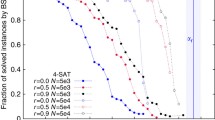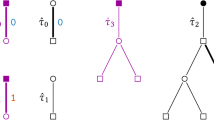Abstract:
The computational complexity of solving random 3-Satisfiability (3-SAT) problems is investigated using statistical physics concepts and techniques related to phase transitions, growth processes and (real-space) renormalization flows. 3-SAT is a representative example of hard computational tasks; it consists in knowing whether a set of αN randomly drawn logical constraints involving N Boolean variables can be satisfied altogether or not. Widely used solving procedures, as the Davis-Putnam-Loveland-Logemann (DPLL) algorithm, perform a systematic search for a solution, through a sequence of trials and errors represented by a search tree. The size of the search tree accounts for the computational complexity, i.e. the amount of computational efforts, required to achieve resolution. In the present study, we identify, using theory and numerical experiments, easy (size of the search tree scaling polynomially with N) and hard (exponential scaling) regimes as a function of the ratio α of constraints per variable. The typical complexity is explicitly calculated in the different regimes, in very good agreement with numerical simulations. Our theoretical approach is based on the analysis of the growth of the branches in the search tree under the operation of DPLL. On each branch, the initial 3-SAT problem is dynamically turned into a more generic 2+p-SAT problem, where p and 1 - p are the fractions of constraints involving three and two variables respectively. The growth of each branch is monitored by the dynamical evolution of α and p and is represented by a trajectory in the static phase diagram of the random 2+p-SAT problem. Depending on whether or not the trajectories cross the boundary between satisfiable and unsatisfiable phases, single branches or full trees are generated by DPLL, resulting in easy or hard resolutions. Our picture for the origin of complexity can be applied to other computational problems solved by branch and bound algorithms.
Similar content being viewed by others
Author information
Authors and Affiliations
Additional information
Received 10 March 2001
Rights and permissions
About this article
Cite this article
Cocco, S., Monasson, R. Statistical physics analysis of the computational complexity of solving random satisfiability problems using backtrack algorithms. Eur. Phys. J. B 22, 505–531 (2001). https://doi.org/10.1007/s100510170101
Issue Date:
DOI: https://doi.org/10.1007/s100510170101




